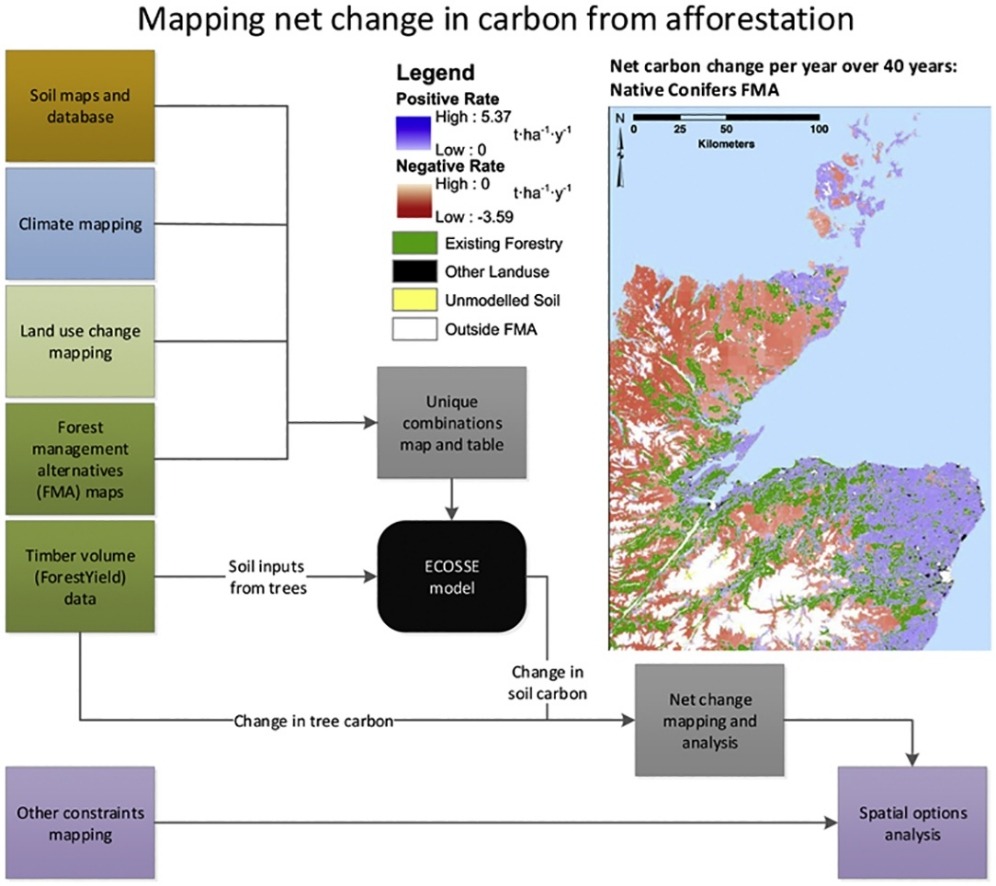Found this new paper really interesting.
It considers future tree planting scenarios in Scotland & their implications for carbon sequestration.
https://www.sciencedirect.com/science/article/pii/S0264837719304041
I have attempted to bring together some of the messages in this thread.
1/20
It considers future tree planting scenarios in Scotland & their implications for carbon sequestration.
https://www.sciencedirect.com/science/article/pii/S0264837719304041
I have attempted to bring together some of the messages in this thread.
1/20
It integrates soil, climate and land-use data with future reforestation scenarios to assess carbon accumulation over time.
2/
2/
An online mapping tool allows you to explore net carbon consequences under different afforestation types.
https://woodlandexpansion.hutton.ac.uk/
Showing the area of suitability for each afforestation category and the net carbon benefit (blue = net sequestration, red = net loss).
3/
https://woodlandexpansion.hutton.ac.uk/
Showing the area of suitability for each afforestation category and the net carbon benefit (blue = net sequestration, red = net loss).
3/
The current focus of tree planting targets is on areas e.g. 100,000 ha target for Scotland from 2012-2022. This paper demonstrates that area-based targets can lead to perverse outcomes, the wrong tree in the wrong place could lead to overall emissions for decades.
4/
4/
Understanding the circumstances (forest type, climate, soil type, initial soil carbon) that will lead to overall carbon accumulation is crucial.
5/
5/
The paper shows that on average most Forest Management Alternatives (i.e. forest scenarios) are making positive contributions to carbon sequestration by 40yrs (if marginal in some cases). But questions how relevant this will be to our short term emissions reduction goals.
6/
6/
A few of the key messages from this work:
Take home message 1: the area suitable for native broadleaf forest is the largest vs. productive Douglas Fir which has the smallest area of availability.
7/
Take home message 1: the area suitable for native broadleaf forest is the largest vs. productive Douglas Fir which has the smallest area of availability.
7/
However, across c.50% of the area suitable for broadleaf forest there would be net carbon losses, continuing over long timescales vs. higher rates of sequestration under Douglas Fir (in the smaller area that is suitable for it).
8/
8/
Take home message 2: Conversion of semi-natural vegetation cover has a high likelihood of net carbon losses, with emission continuing to 80 yrs under many of the scenarios.
9/
9/
Take home message 3: Under all scenarios, planting of former cropland leads to net carbon sequestration.
10/
10/
Take home message 4: Even the most productive forest types lead to net carbon losses on organo-mineral soil, failing to meet carbon sequestration targets on the short timescales (i.e. 2050 targets).
11/
11/
Take home message 5: Current regulations to prevent planting on deep peat will not exclude the potential for overall carbon release due to disturbance of carbon-rich soils.
12/
12/
This paper provides really useful context for future land-use policy. At the moment most new forest planting is targeted to less productive agricultural land, this carries a greater risk of inadvertent carbon release from carbon rich soils that are vulnerable to disturbance.
13/
13/
Balancing agriculture & farming to maximise overall carbon sequestration for forest planting will be crucial & we therefore need thoughtful policy to inform tree planting decisions.
14/
14/
The paper shows that the carbon sequestration potential from native broadleaf forest is greatest on productive land (where currently it is rarely established) – suggesting opportunities for integrating this forest type into agricultural systems.
15/
15/
Finally, there are many other key objectives for tree planting e.g. biodiversity conservation. Sometimes there will be synergy between this & carbon.
16/
16/
But if we define our new forests solely on their potential for carbon storage there is a risk that we compromise these other goals.
17/
17/
There are of course further considerations that need to be addressed: this paper focuses on the carbon balance in the soil and trees. Considering the future of forest products (emphasising long-lasting products) is key to the overall carbon balance from productive forests.
18/
18/
Overall, as enthusiasm for tree planting is taking off, and most targets are for area of forest established per year, this paper provides some well-needed nuance to the debate & highlights the risks of assuming overall carbon storage from these simplistic targets.
19/
19/
I had no involvement in this paper, but am really excited to see it bringing together some key themes relating to my research & that I think are important in considering forest expansion as a nature-based solution in Scotland.
20/20
20/20

 Read on Twitter
Read on Twitter



